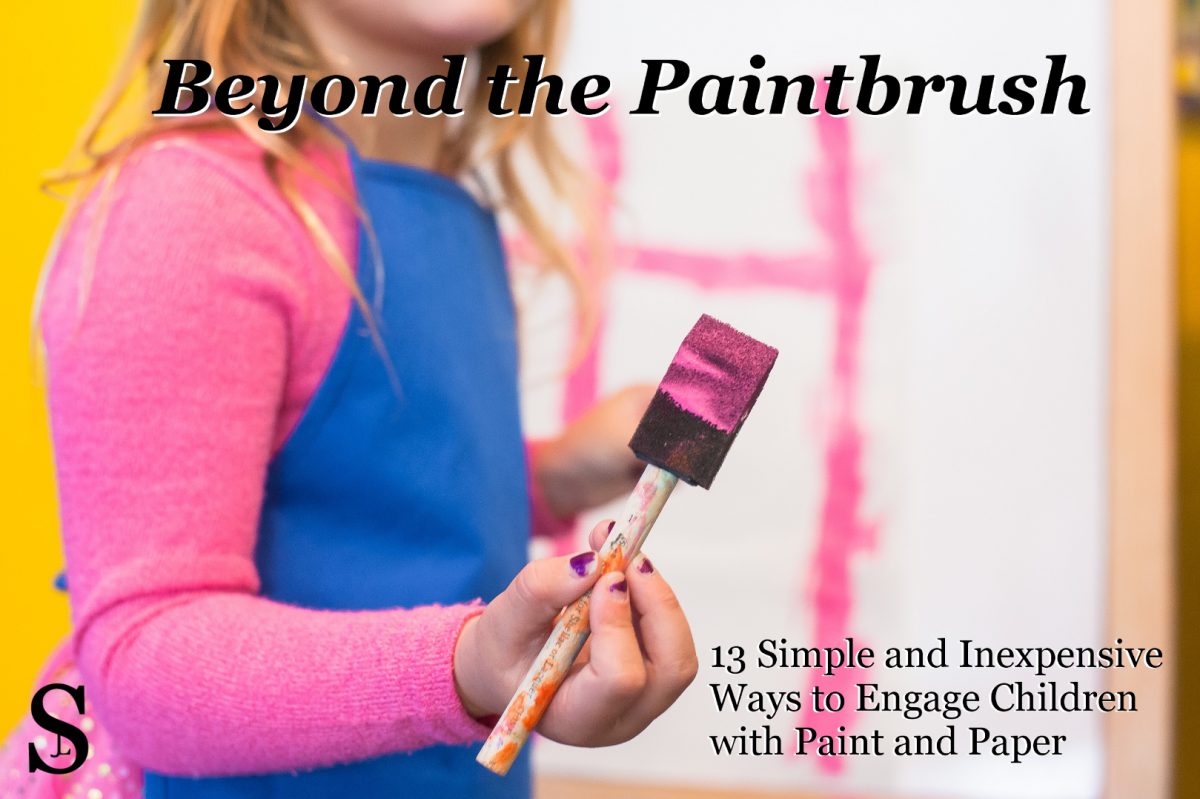
13 Simple and Inexpensive Ways to Engage Children with Paint and Paper
Perhaps you have some washable paint laying around, but want to change things up. There are many fun alternatives to paintbrushes. Several of them have valuable developmental bonuses for your child beyond merely strengthening creativity.
Basic tools to use instead of paintbrushes:
-
Fingers (All ages)
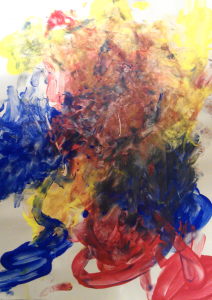
- Messy and delightful for most children, simply allowing your child the freedom to finger paint is an excellent sensory experience.
- Some children dislike the sensation of paint on their fingers. If that is your child, try modelling by doing some finger painting of your own. Reassure them that you’ll help them wash their hands after. If they still resist, don’t push them. Rather, work your way toward it by giving them tools such as sponges where their fingers will likely get a little paint on them, but not as much as with finger painting.
-
Sponges (All ages)
- A straightforward painting experience. Gives the child an opportunity to experiment with gentle and firm pressure.
- Take an unused sponge and cut it into easy to hold sizes. Rectangles, roughly 8cm tall and 4cm by 4cm on the ends, work well for small hands. Alternatively, if you want to get really creative, you can cut the sponge into shapes such as trees, hearts, or fish.
- Expect sponge painting to be messy. Only put small amounts of paint for the child to dip the sponge in, as they can easily get an excessive amount of paint.
- Sponge painting works well with stencils.
-
Cotton swabs/Q-tips® (2.5 years+)
- A personal favourite of mine. The small size of cotton swabs helps exercise the child’s fine motor muscles – the hand muscles used for holding a pencil among many other things. Cotton swabs allow the children to paint dots or small lines – far more detailed than most kids’ paintbrushes. I find the Q-tips® brand works well.
- Some 2 year olds may find cotton swabs too small to grasp easily and thus may not enjoy using them. Therefore, I recommend them for children 2.5 years old and up.
- Because cotton swabs are small, it takes more time for the child to fill the page, which encourages them to focus longer than with a large paintbrush. With this in mind, it may be wise to use only half a sheet of paper when working with cotton swabs to make filling the page more attainable.
- Depending on the child, painting with cotton swabs can be relatively clean.
-
Yarn (2.5 years+)
- Children can create beautiful works of modern art when painting with
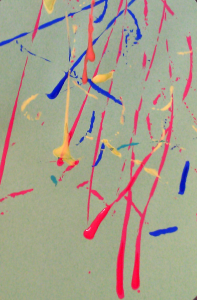 a short piece of yarn, and they enjoy doing it. While they’re at it, they will be strengthening their arm muscles by the abundance of up and down and side to side movements.
a short piece of yarn, and they enjoy doing it. While they’re at it, they will be strengthening their arm muscles by the abundance of up and down and side to side movements. - Cut yarn into pieces roughly 8cm in length. I like to have one piece of yarn per colour of paint. Inevitably a few strings will be dropped into the paint leaving them entirely paint saturated. Therefore, I try to have extra strings cut and ready to use for such emergencies.
- I recommend using a shallow dish to hold the paint for easy dipping. To start, it may help to use a finger to submerge one end of the yarn into the paint.
- This yarn painting can get messy. The finished products, however, typically look attractive.
- Children can create beautiful works of modern art when painting with
-
Fork (3.5 years+)
- For a unique challenge, hand the child a plastic fork and a shallow dish of paint. Fun picture ideas could be a flower, a chick, or grass. This experience strengthens hand-eye coordination. Problem-solving is also required if trying to paint a specific object.
- Keeping the paper small is advised as children may not have the attention span needed to fill a whole page.
-
Toothbrush (4 years+)
- Want a major fine motor muscle strengthener? Bring out the toothbrush and prepare for a fun, messy time!
- Toothbrush painting only takes a small amount of paint, but it may be helpful to add a drop of water to the paint. Cover the table and surrounding area or be prepared to wipe it as it will get messy.
- Encourage the child to hold the toothbrush
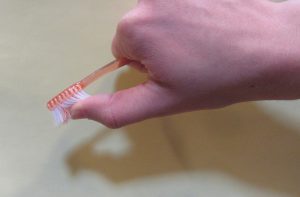 with its bristles facing the paper. Show them how to run their thumb (or finger from the other hand) through the bristles causing the brush to spray droplets of paint onto the paper.
with its bristles facing the paper. Show them how to run their thumb (or finger from the other hand) through the bristles causing the brush to spray droplets of paint onto the paper. - Expect most children to have a short attention span for this activity as their hand muscles will likely tire quickly – evidence that it is good exercise for those fine motor muscles.
Things to dip in paint:
Be aware that toys with metal parts may rust if exposed to water when cleaning paint off of them. Also, it may not be possible to get all the paint off whatever items you use, therefore, pick carefully.
-
Jar/bottle lids (2.5 years+)
- Wash and save various bottle and jar lids, then pour paint on a plate and let your child use the lids as stamps. They might make a snowman, a flower, or a lovely modern art pattern. Their fine motor muscles will be strengthened by the various grips required to hold the lids.
- If your child is prone to putting items in his/her mouth, beware that small lids may be choking hazards.
- This can get messy and lids can become slippery when paint-covered and thus may fall on the floor. Therefore, if you are working over carpet you may want to cover the floor.
-
Dinosaurs (2 years+)
- Choose some large washable dinosaurs (the smoother their skin the easier to clean – avoid those with metal). Encourage your child to “walk” the dinosaurs through a plate of paint and across their paper leaving dinosaur footprints. The dinosaurs have a fair amount of weight which, combined with all those up and down movements, will strengthen important arm muscles.
- Children love this activity! However, I caution against using this “dip your toys in paint” idea with young children who do not yet grasp the concept that only certain toys are okay in paint at certain times. The last thing we want is their teddy doing a faceplant in the paint dish.
-
Cars (2 years+)
- If you have some primarily plastic cars with no internal mechanisms which may be damaged by water, this activity can be tremendously thrilling! What’s the developmental value of it? If you give the child an extra large piece of paper to drive their car across, they will likely make many large, full-arm movements using muscles needed for writing. These types of large arm movements are especially important for development in 2-3 year olds.
- Pour the paint onto a plate and encourage the children to drive the cars back and forth in the paint to coat the wheels before driving the cars around on the paper.
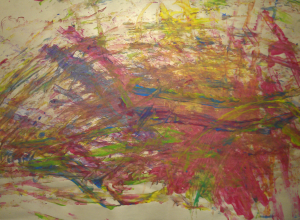
- If you have the option, this is a good activity to cover the entire table with paper for the cars to leave tracks on.
- As with the dinosaurs above, I caution against doing this with young children who may not yet realize that this does not give them permission to drive the cars through any other sticky paste they can find.
Paper
Changing up the paper is another way to keep painting fresh and exciting.
-
Size
- Change up the size of paper you give your child.
- If they are painting with something small, have only a short amount of time, or have a short attention span, use a small piece of paper.
- If they enjoy painting, have plenty of time, or are using a large tool, use a full-size piece of paper.
- Using bigger papers can encourage healthy arm muscle development as they reach to paint on the far edge of the paper.
- Change up the size of paper you give your child.
-
Shape
- Before it’s time to paint, cut the paper into a simple shape such as a triangle, heart, circle, or fish. Then allow the child to paint however they want.
-
Whole table
- On occasion, covering the whole table with paper and allowing several children to paint on it at once can be a fun change. The children often enjoy being able to paint long lines without running into the edge of the paper. On top of that, having several children painting on the same surface gives a social development aspect to painting.
-
Colouring sheets
- Some painting techniques work well on colouring pages. Younger children could use sponges, while older children could use cotton swabs which allow them to paint inside the lines.
Have fun painting!
What are your favourite paintbrush alternatives for preschool painting?

